El software de videoconferencia se ha vuelto esencial en un mundo donde las interacciones en persona son un lujo. Los trabajadores remotos, los dueños de negocios y las familias confían en plataformas confiables y ricas en funciones para mantenerse conectados. Por lo tanto, si estás buscando el mejor software de videoconferencia para mejorar tu juego de comunicación, hemos seleccionado una lista de las 10 mejores opciones.
Introducción
El trabajo remoto se ha vuelto cada vez más popular en los últimos años, gracias en gran parte al auge de la tecnología de videoconferencia. La videoconferencia permite a los empleados colaborar y comunicarse eficazmente, independientemente de su ubicación.
Pero con tantas herramientas de videoconferencia diferentes disponibles, puede ser difícil elegir la adecuada para tus necesidades. En este artículo, analizaremos las consideraciones clave que debes tener en cuenta al elegir una herramienta de videoconferencia, y también revisaremos las 10 mejores herramientas de videoconferencia en el mercado actual.
Consideraciones
Al seleccionar la herramienta de videoconferencia más apropiada para trabajar, hay ciertas consideraciones que tener en cuenta. Esto incluye las capacidades de alojamiento de la herramienta y las consideraciones relacionadas con la integración. Las 10 herramientas enumeradas en este artículo se han seleccionado después de asegurar que cumplen con las consideraciones enumeradas a continuación:
Escalabilidad
Las herramientas de videoconferencia deben poder escalar para satisfacer las necesidades de empresas de todos los tamaños, desde pequeños equipos hasta grandes empresas. Deben ser capaces de manejar tanto pequeñas reuniones como grandes seminarios web con facilidad. También es importante considerar la capacidad de la herramienta para soportar diferentes métodos de autenticación, como el inicio de sesión único (SSO), para garantizar la seguridad de los participantes de la reunión.
Integración multiplataforma
En el entorno de trabajo híbrido actual, es esencial que las herramientas de videoconferencia sean accesibles a través de una variedad de dispositivos y plataformas. Los usuarios deben poder unirse a las reuniones desde sus computadoras portátiles, computadoras de escritorio, teléfonos inteligentes y tabletas, independientemente de su sistema operativo. La herramienta también debe ser fácil de usar en todos los dispositivos, con una experiencia de usuario consistente en todas las plataformas.
Calidad de video y audio
El video y el audio de alta calidad son esenciales para una videoconferencia eficaz. La herramienta debe ser capaz de entregar video y audio claros y nítidos, incluso en condiciones de bajo ancho de banda. También debe tener características para reducir el ruido y el eco, y para ajustarse a diferentes condiciones de iluminación.
Características adicionales
Además de las características principales de escalabilidad, integración multiplataforma y calidad de video y audio, hay una serie de otras características que las empresas deben considerar al elegir una herramienta de videoconferencia. Éstas incluyen:
- Seguridad: La herramienta debe tener características de seguridad sólidas para proteger los datos de la reunión del acceso no autorizado. Esto incluye características como el cifrado de extremo a extremo, las contraseñas de las reuniones y las salas de espera.
- Compartir pantalla: La capacidad de compartir pantallas es esencial para la colaboración y las presentaciones. La herramienta debe facilitar el compartir pantallas con los participantes de la reunión, y debe permitir tanto el compartir la pantalla completa como el compartir una parte de la pantalla.
- Grabación: La capacidad de grabar reuniones es útil para la formación, la documentación y el compartir con los participantes ausentes. La herramienta debe permitir la fácil grabación de las reuniones, y debe proporcionar opciones para descargar y compartir las grabaciones.
- Función de chat: Una función de chat permite a los participantes de la reunión comunicarse entre sí sin interrumpir al orador. Esto puede ser útil para hacer preguntas, compartir enlaces y colaborar en documentos.
- Controles de moderador: Los controles de moderador permiten a los anfitriones de la reunión gestionar la reunión y asegurar que se desarrolle sin problemas. Esto incluye características como silenciar a los participantes, eliminar a los participantes y finalizar la reunión.
- Fondos personalizables: Los fondos personalizables permiten a los participantes de la reunión crear un entorno profesional y sin distracciones para sus reuniones. La herramienta debe proporcionar una variedad de imágenes y videos de fondo, y también debe permitir a los participantes cargar sus propios fondos personalizados.
Al considerar los factores enumerados anteriormente, las empresas pueden elegir la mejor herramienta de videoconferencia para sus necesidades.
Una combinación de las características anteriores, así como las otras consideraciones discutidas, proporciona las herramientas de videoconferencia más accesibles y efectivas para su uso en una variedad de campos. 10 de estas herramientas se discuten en detalle a continuación:
Las 10 mejores herramientas de videoconferencia - Gratuitas y seguras
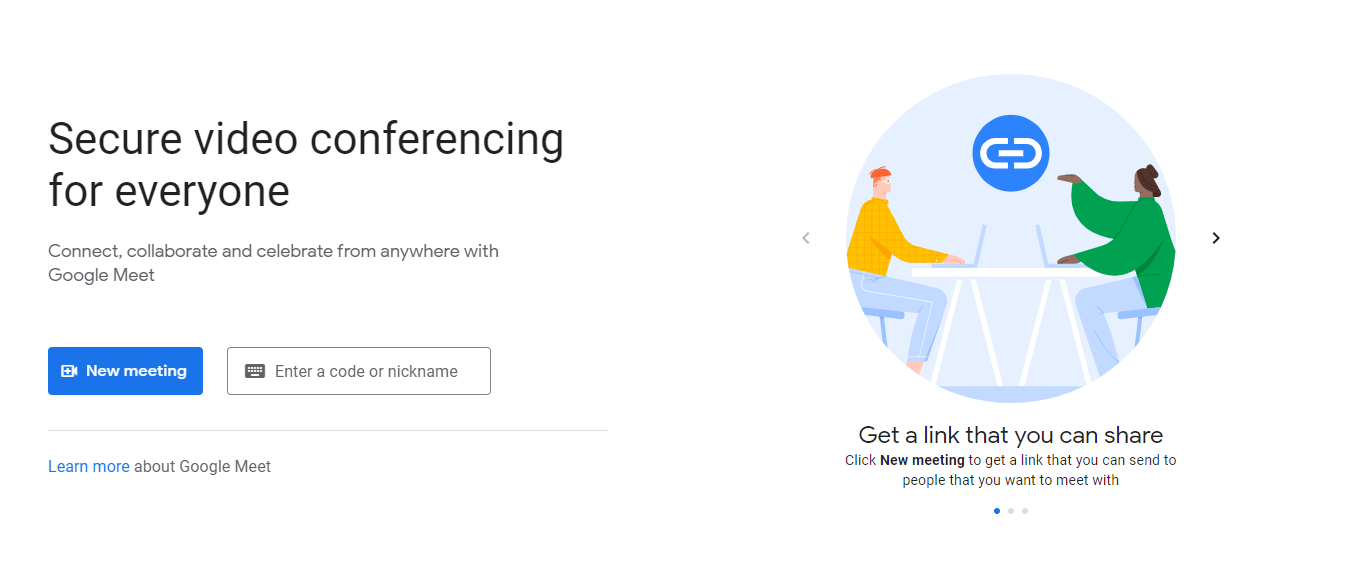
Google Meet
Google Meet es una herramienta de videoconferencia integrada con Google Workspace y se lanzó por primera vez en 2017 como una alternativa “mejor” a Hangouts, una aplicación de chat y videoconferencia desarrollada previamente también creada por Google. Meet se considera una herramienta fácil de usar y altamente adaptable, especialmente útil para lugares de trabajo donde se utilizan regularmente otras herramientas de Google.
Características
- Pizarra blanca
- Reunirse mientras usa Docs o Jamboard
- Salas de reunión separadas
- Levantar la mano
- Reacciones
Pros
- Fácil colaboración: las conferencias de Google Meet se pueden llevar a cabo en Google Docs y Jamboard, por lo que los equipos que trabajan en proyectos pueden editar juntos en la llamada, lo que acorta el proceso y es una forma eficaz de llevar a cabo tareas grupales.
- Grabación automatizada: las capacidades de grabación de Meet son extensas, ya que ofrece grabaciones automatizadas y grabaciones manuales editables para facilitar el acceso y el uso compartido.
- Integración con Google Workspace: como Google Meets es un producto de Google Workspace, es fácil de usar de forma adyacente y se facilita con otros componentes del espacio de trabajo. Por ejemplo, las grabaciones de Google Meet se pueden guardar en Google Drive y se puede acceder fácilmente a las reuniones a través de la función de chat en Gmail.
Contras
- El límite de tiempo en reuniones más grandes: si bien las reuniones individuales pueden durar hasta 24 horas, cualquier reunión con más de 3 miembros está limitada a 1 hora en la versión gratuita. Las cuentas de trabajo y las premium tienen diferentes limitaciones de tiempo.
- Límite de participantes: la versión gratuita de Meet permite que un máximo de 100 usuarios estén en el mismo espacio de reunión en un momento dado, lo que puede ser bastante limitante para las empresas que tienen una fuerza laboral más grande o necesitan una herramienta que facilite el alojamiento de seminarios web.
- Sin sala de espera: a diferencia de la mayoría de las herramientas enumeradas en este artículo, Meet no proporciona una sala de espera para los usuarios. Los anfitriones pueden restringir el acceso, pero la mayoría de las veces esto resulta en que los usuarios “esperen” en una pantalla de “carga” perpetua en lugar de un espacio de espera configurado.
Google Meet sigue siendo una de las herramientas de conferencia más favorecidas en esta lista y en el mercado por su interfaz fácil de usar, así como por sus capacidades de integración. Aunque la versión gratuita tiene su buena cantidad de limitaciones, las empresas que buscan estas características específicas pueden considerar esta herramienta como una inversión que vale la pena y suscribirse a las versiones premium disponibles.

Teams
Microsoft Teams es un componente de Microsoft 365. Se inició aproximadamente al mismo tiempo que Meet, pero se considera más holístico, ya que abarca áreas como la productividad y el trabajo en equipo. Con una extensa lista de características, como canales de conversación e integración con Outlook, se considera una herramienta que se especializa en aumentar la productividad en el lugar de trabajo, especialmente donde la mayoría de los trabajadores pueden ser remotos.
Características
- Canales de conversación
- Colaboración interna y externa
- Chat instantáneo
- Integración de Outlook y Teams
- Anotaciones colaborativas
Pros
- Programación fácil de reuniones: programar reuniones en Teams es un proceso bastante simple, ya que puedes hacerlas recurrentes y asignar las reuniones a canales de conversación específicos.
- Espacio personalizable: la mayoría de las reuniones son altamente personalizables, al igual que el aspecto de la interfaz de usuario de Teams. Los usuarios pueden elegir colores que correspondan a su empresa y cambiar el nombre de los segmentos en consecuencia.
- Historial de mensajería en tiempo real: los mensajes compartidos dentro de un chat de videoconferencia se almacenan de tal manera que puedes rastrearlos hasta sus orígenes. De esta manera, se mantiene un registro de los chats en tiempo real sin la necesidad de una interpretación manual.
Contras
- Curva de aprendizaje pronunciada: dada su conjunto único de características y su formato de archivo bastante complejo, Microsoft Teams puede ser más difícil de navegar para los nuevos usuarios y puede presentar una curva de aprendizaje más pronunciada para los empleados.
- Un número limitado de canales (200 públicos/30 privados): El número de canales por lugar de trabajo puede ser bastante limitante. Aunque 200 canales pueden parecer un número grande, las corporaciones más grandes a menudo requieren canales para cada esfuerzo y pueden alcanzar rápidamente este número.
- Duración de la grabación de la reunión: la duración de las grabaciones de las reuniones solo dura hasta 4 horas, después de lo cual la grabación se detiene automáticamente. Esto puede ser bastante desventajoso, ya que ciertas reuniones y seminarios web pueden durar mucho más de 4 horas.
Si bien Teams proporciona capacidades de videoconferencia, se recuerda a los usuarios que es una especie de lugar de trabajo virtual y no necesariamente se especializa en videoconferencia. Sin embargo, es bastante capaz y es el anfitrión de muchas características únicas y oportunas para mejorar la comunicación efectiva.
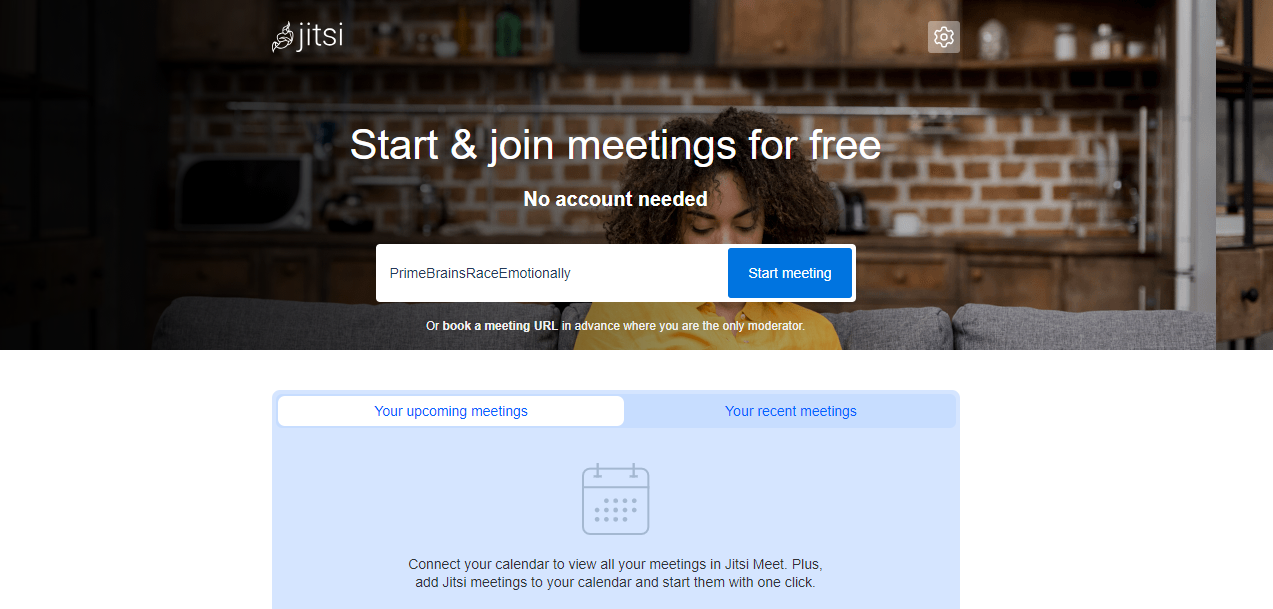
Jitsi Meet
Jitsi Meet es una herramienta de videoconferencia construida sobre software de código abierto, lo que la convierte en una plataforma fácil de usar y orientada a la comunidad para realizar videoconferencias. Está equipada con un conjunto de características que permiten que se use en múltiples dispositivos, en muchas plataformas y en cualquier área del mundo. En particular, emplea arquitectura Jitsi y es conocida por su naturaleza altamente segura.
Características
- Compartir presentaciones
- Grabaciones de audio/video
- Informes y estadísticas
- Transmisión de video
- Chat privado
Pros
- Código abierto: como una plataforma de código abierto, Jitsi Meet está avanzando constantemente para satisfacer las necesidades específicas de los usuarios. Esta naturaleza flexible le permite cumplir con los estándares de una amplia variedad de industrias.
- Naturaleza altamente segura: está integrado con JWT y está equipado con varios niveles de autenticación lo que le permite ser una herramienta de videoconferencia altamente segura
- No se requiere registro: es una de las únicas herramientas en esta lista que no requiere un registro específico, lo que la hace bastante fácil de usar en una variedad de dispositivos y navegadores, incluso cuando los trabajadores pueden estar en movimiento.
Contras
- Sin pizarra virtual: a diferencia de la mayoría de las herramientas en esta lista, Jitsi Meet no ofrece capacidades de anotación a través de una pizarra blanca, lo que puede ser bastante difícil de solucionar para los usuarios.
- Múltiples moderadores: en las conferencias de Jitsi Meet, puede haber múltiples moderadores, lo que puede hacer las cosas más complicadas de lo necesario.
- Sin opción de compartir archivos: dado que Jitsi Meet se centra principalmente en la videoconferencia, no facilita mucho más. Tiene una función de chat y encuestas interactivas, pero el uso compartido de archivos solo se puede hacer a través de vínculos de retroceso.
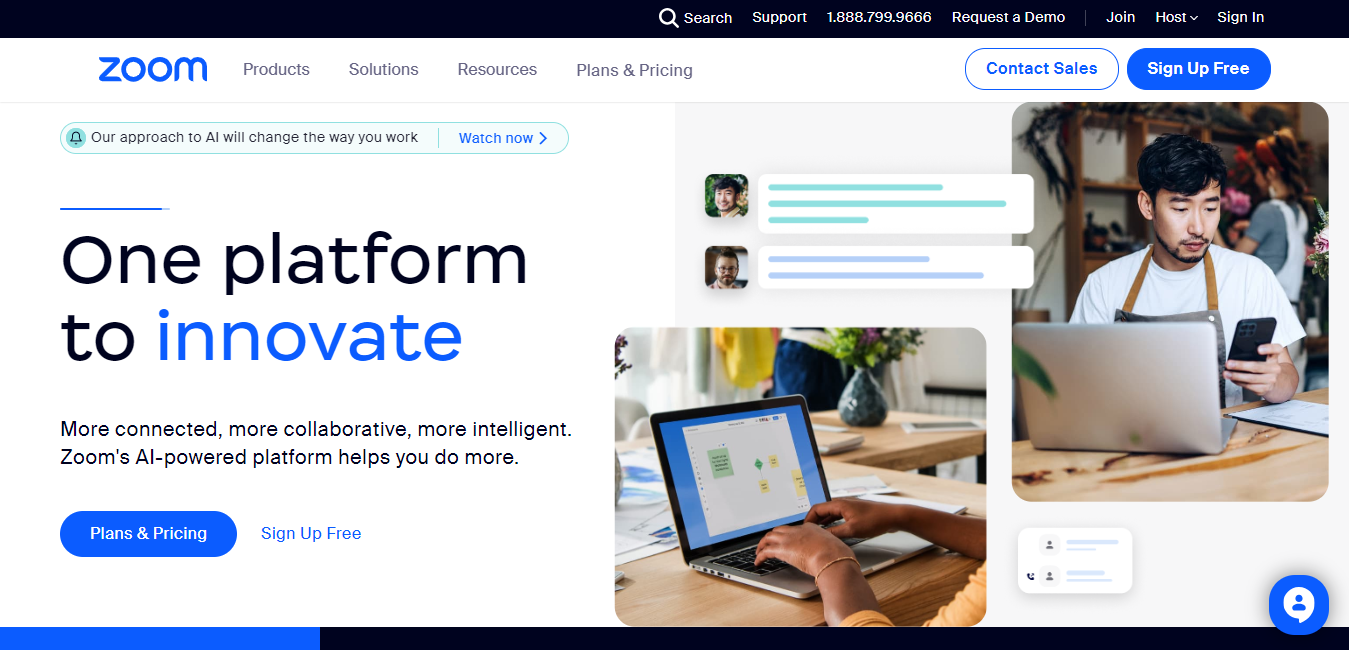
Zoom
Una de las herramientas de videoconferencia más conocidas en el mercado es Zoom, especialmente dada su resurgimiento en popularidad debido a la pandemia de Covid-19. Zoom es una plataforma refrescante con una infraestructura intuitiva y una interfaz fácil de navegar. Es especialmente útil para educadores y trabajadores remotos.
Características
- Personalizaciones
- Modo de enfoque
- Vista de galería
- Compartir pantalla
- Reuniones programadas
Pros
- Altamente personalizable: Zoom proporciona fondos virtuales personalizables, efectos de desenfoque, así como otras características que permiten a las empresas y a los usuarios hacer la experiencia más personalizada.
- Capacidades de grabación: Zoom permite la grabación de reuniones de tal manera que los archivos grabados se guardan directamente en el dispositivo que se está utilizando.
- UI intuitiva: su interfaz es intuitiva y fácil de interactuar incluso para los usuarios principiantes.
Contras
- Limitaciones de tiempo: las reuniones de Zoom gratuitas solo duran alrededor de 40 minutos, lo que puede ser un tiempo bastante corto en comparación con la mayoría de las otras herramientas mencionadas en este artículo.
- Preocupaciones de seguridad: en el pasado reciente, Zoom ha adquirido bastantes acusaciones con respecto a la seguridad de la información compartida dentro de sus salas de reuniones dado que no incorpora el cifrado de extremo a extremo.
- Uso intensivo de recursos: como es una herramienta bastante compleja con una infraestructura optimizada, consume muchos recursos y, a menudo, ocupa un gran espacio dentro de los dispositivos en los que está instalado.
Zoom puede estar entre una de las herramientas de videoconferencia más conocidas, pero aún es bueno aconsejar precaución al usarla. Especialmente si la naturaleza de las reuniones que se celebran es sensible. Por otro lado, no muchas herramientas brindan la facilidad de conveniencia que se puede encontrar en Zoom.
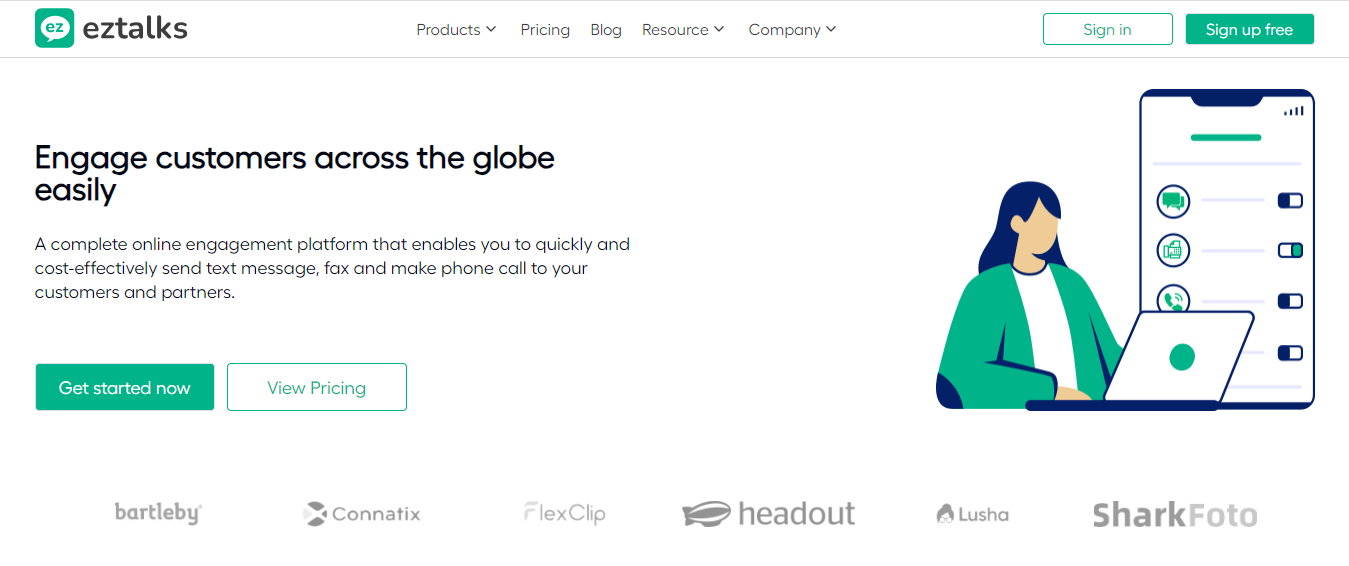
EzTalk
EzTalk es una plataforma de participación que combina SMS, videoconferencia y capacidades de fax en una sola herramienta para proporcionar la experiencia de comunicación más completa. Es conocido por su interfaz fácil de usar y su diseño simple, lo cual es conveniente para los usuarios independientemente de su experiencia técnica.
Características
- Calidad HD
- Compartir pantalla
- Pizarra blanca
- Compartir contenido
- Panel de actividad
Pros
- UI fácil de usar: la interfaz es un aspecto importante a considerar al elegir una herramienta de videoconferencia y EzTalk tiene una interfaz bastante fácil de usar.
- Integración perfecta: se integra fácilmente con las plataformas existentes y se puede usar en múltiples dispositivos.
- Servicios SMS: su integración se fortalece aún más por su capacidad para proporcionar servicios SMS masivos
Contras
- Falta de personalización: su diseño simple significa que no está abierto a la personalización, lo que puede hacer que la experiencia sea bastante rígida y hacer que los usuarios se sientan menos como en casa en la plataforma.
- Puede ser lento: a diferencia de otras herramientas mencionadas anteriormente, EzTalk es bastante limitado en sus capacidades técnicas y no recibe tantas actualizaciones. Esto puede hacer que tenga errores y experimente retrasos con más frecuencia que otras plataformas.
- Se requiere Internet estable y rápido: para que EzTalk se ejecute a su nivel óptimo, requiere un flujo constante de Internet de mayor ancho de banda, lo que puede no estar disponible para todos los usuarios en todo momento.
EzTalk es una solución bastante razonable para los usuarios que buscan una solución de videoconferencia simple y fácil, especialmente porque no tiene muchas limitaciones en cuanto al tiempo y la cantidad de participantes. Sin embargo, debe usarse teniendo en cuenta las limitaciones existentes.
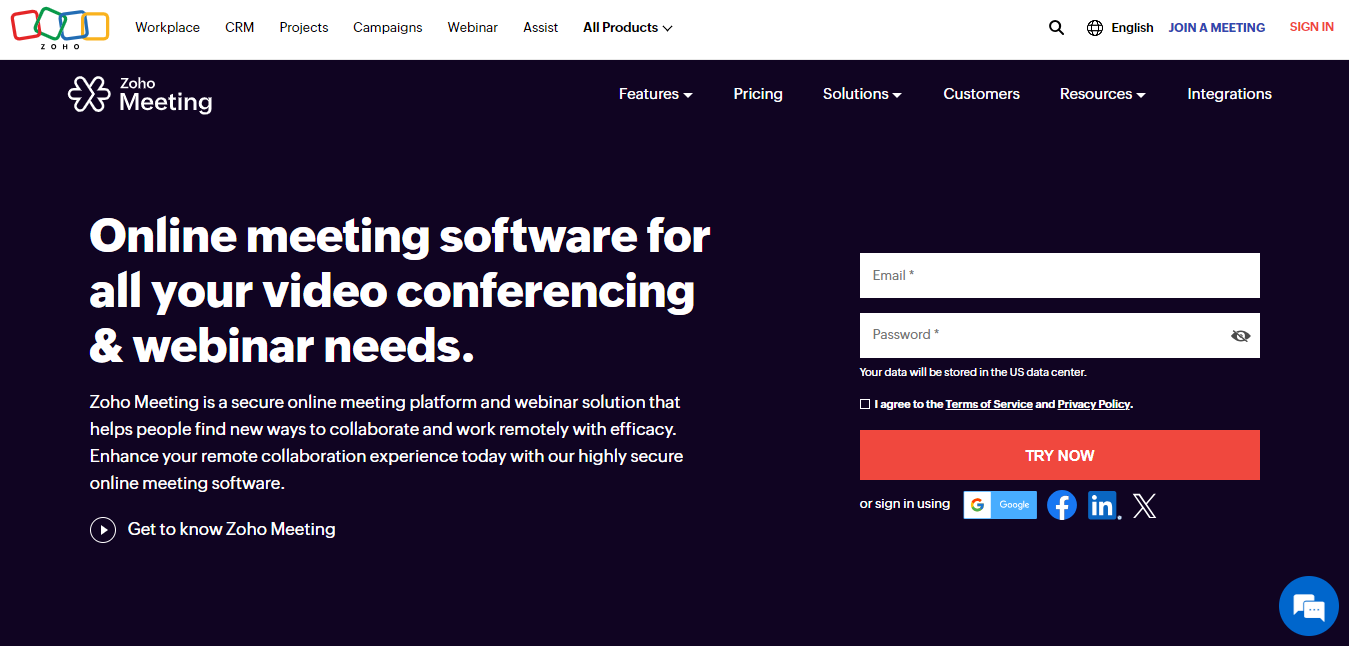
Zoho Meeting
Zoho Meeting ofrece soluciones de seminarios web y videoconferencias a trabajadores remotos, así como a instituciones que buscan organizar reuniones para una gran cantidad de usuarios. Es una plataforma única que enfatiza el intercambio seguro de información y el soporte las 24 horas. Dado que pertenece al ecosistema de Zoho, se integra fácilmente en muchas otras plataformas y lugares de trabajo también.
Características
- Confirmación de asistencia y recordatorios
- Sincronización con el calendario
- Enlace de reunión integrado
- Agregar coanfitrión
- Encuestas en vivo
Pros
- Requisito de bajo ancho de banda: Zoho Meeting funciona bien incluso con bajo ancho de banda, ya que su dependencia de Internet es mucho menor que otras plataformas de videoconferencia.
- UI intuitiva y fácil de usar: tiene una interfaz atractiva y es bastante interactiva, lo que hace que la experiencia sea agradable incluso para los usuarios principiantes.
- Seguro: su énfasis en la seguridad proviene de los muchos factores de autenticación implementados, como el cifrado de extremo a extremo y la protección con contraseña.
Contras
- Susceptible a retrasos: al igual que EzTalk, Zoho Meeting es una plataforma que es bastante rígida y puede sufrir retrasos si se ve abrumada.
- Falta de herramientas de anotación: es bastante interactivo, pero no está equipado con muchas herramientas de anotación que pueden reducir su atractivo.
- Falta de personalización avanzada: dado su formato bastante simple, no es tan personalizable como la mayoría de las plataformas diseñadas especialmente para videoconferencias.
Zoho Meeting es una versión única de la videoconferencia, aunque es bastante nueva en el mercado y puede ser menos avanzada tecnológicamente que algunas otras plataformas conocidas. Su interfaz intuitiva y el requisito de ancho de banda mínimo la convierten en una excelente plataforma para que los nuevos usuarios interactúen.
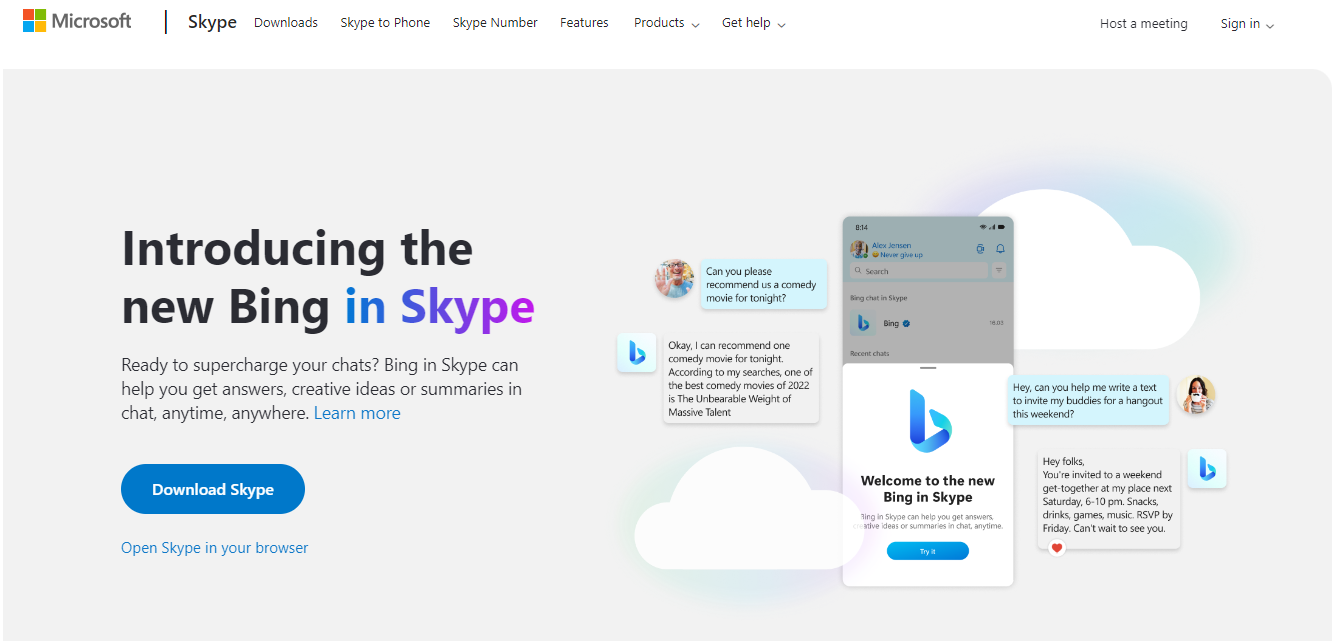
Skype
No muchas plataformas de videoconferencia han alcanzado las alturas que ha alcanzado Skype, con su interfaz fácil de usar y su larga historia de resistir las mareas del tiempo. Ha capturado de manera única la esencia de las interacciones humanas a través de Internet y se erige como un testimonio de la comunicación efectiva durante las últimas décadas.
Características
- Correo de voz
- Mensajes de texto
- Grabaciones
- Subtítulos en vivo
- Historial de chat
Pros
- Fuerte seguridad: Skype se considera fácilmente un pionero en la videoconferencia segura dada su naturaleza altamente encriptada e interfaz protegida con contraseña.
- Compartir archivos: permite compartir archivos y medios dentro de la plataforma y ayuda a mejorar las discusiones en tiempo real.
- Instalación fácil: es bastante fácil de descargar y ocupa un espacio mínimo en el dispositivo del usuario.
Contras
- Problemas técnicos: Skype alguna vez se consideró la plataforma de videoconferencia más avanzada en el mercado, pero últimamente ha enfrentado algunos problemas técnicos críticos que la hacen un poco menos confiable que antes.
- Uso intensivo de la red: Skype ocupa mucho ancho de banda, lo que puede ser un obstáculo bastante difícil para los trabajadores remotos que no reciben una compensación por el uso de la red.
- Vulnerable al spam y al phishing: en los últimos años, Skype ha tenido que enviar varias advertencias sobre el phishing que ocurre dentro de la plataforma. A pesar de su naturaleza segura, todavía se advierte a los usuarios que tengan cuidado con los mensajes directos de extraños.
Skype es una herramienta de videoconferencia muy querida y confiable, a menudo aclamada como la primera de su tipo. Todavía se usa hoy en día con el mismo fervor a pesar de ciertos problemas circunstanciales.
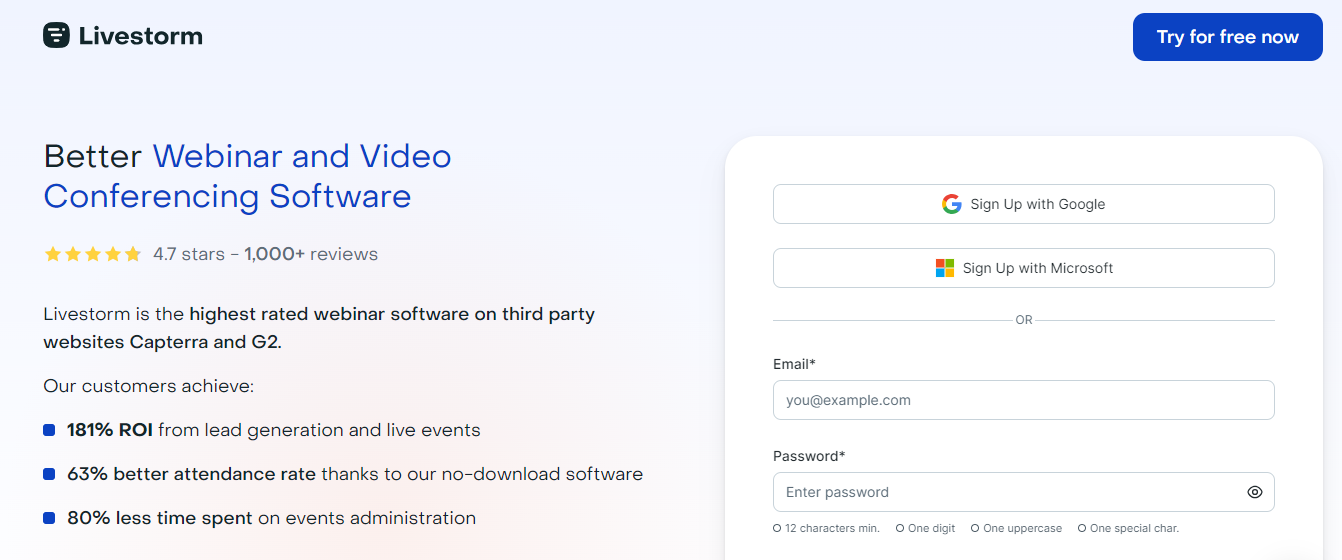
Livestorm
Livestorm es un software de seminarios web que se enorgullece de brindar capacidades de videoconferencia a una gran cantidad de personas y se centra en el marketing. Está equipado de forma única con personalizaciones que permiten a las empresas mostrar su marca a través de la plataforma.
Características
- Capacidades de marca
- Análisis de eventos
- Programación fácil
- Integración de redes sociales
- Encuestas y cuestionarios
Pros
- Páginas de destino personalizadas: Livestorm se dedica a representar a las empresas de una manera personalizada y permite la personalización de las páginas de destino, entre otras cosas.
- Reuniones interactivas: organiza reuniones interactivas al proporcionar encuestas y cuestionarios que permiten a los participantes dar su opinión sin tener que hablar.
- Análisis estadístico: después de las reuniones, Livestorm proporciona comentarios estadísticos y análisis de los eventos celebrados para ayudar a mejorar aún más la calidad de los seminarios web celebrados y facilitar el crecimiento de la empresa.
Contras
- Limitaciones de tiempo: a diferencia de otras plataformas, Livestorm solo permite sesiones de 20 minutos para usuarios gratuitos, lo que apenas es tiempo en retrospectiva.
- Limitaciones de participantes: la versión gratuita también limita la cantidad de participantes que pueden estar en una reunión, limitándola a 10, y obliga a las empresas a comprar paquetes de suscripción para alojar grupos más grandes.
- UI complicada: dada su naturaleza altamente personalizable, tiene una interfaz compleja que puede llevar algo de tiempo acostumbrarse.
Livestorm es ideal para las empresas a las que no les importa gastar una buena cantidad de dinero para ejecutar reuniones altamente personalizables y muy eficientes a largo plazo. Es complicado, pero solo porque se esfuerza por brindar los mejores servicios a sus usuarios.
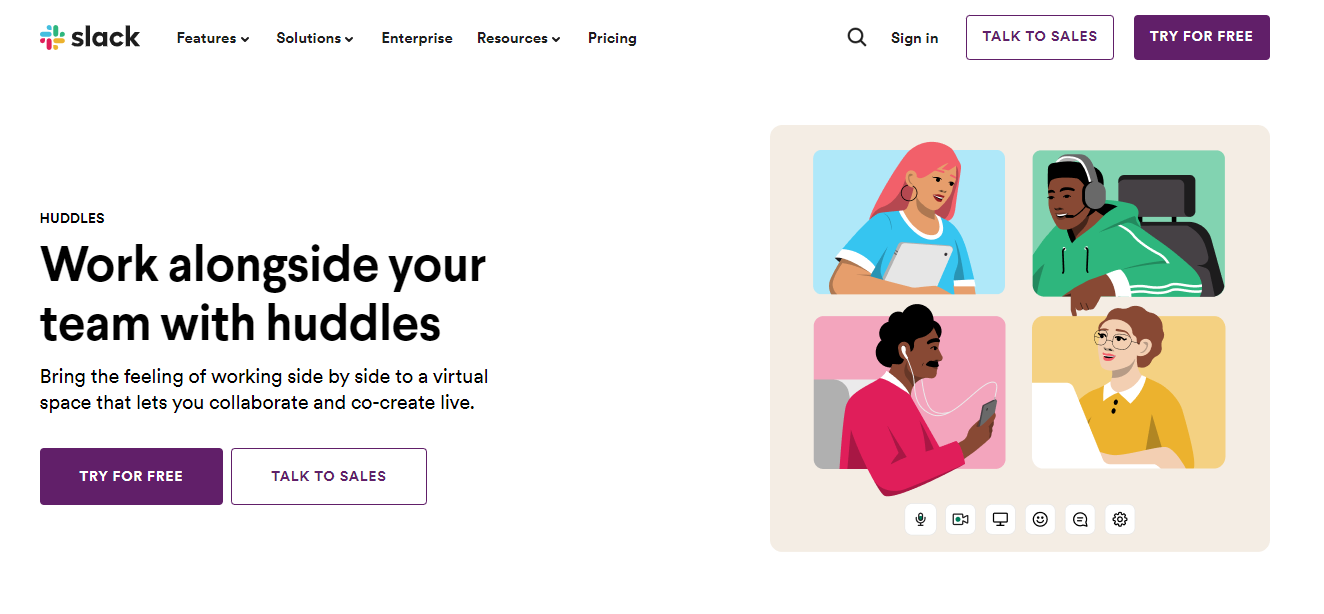
Slack
Slack es una plataforma de productividad que se centra en conectar a los trabajadores de todas las geografías para mejorar la colaboración y fomentar un sentido de comunidad dentro del equipo. Es altamente eficiente y está equipado con una función de videoconferencia que permite la interacción entre los usuarios en un entorno divertido y libre de estrés.
Características
- Planificación de proyectos
- Canales
- Uso compartido de pantalla entre varias personas
- Mensajería directa
- Compartir archivos y medios
Pros
- Fácil integración: Slack es bastante fácil de usar e instalar. Funciona en múltiples dispositivos y es bastante fácil de integrar en los flujos de trabajo existentes.
- Interfaz flexible y fácil de usar: tiene una interfaz que permite que incluso los nuevos usuarios se sientan como en casa y no es complicada incluso para aquellos que pueden ser novatos en la tecnología.
- Canales compartidos: la existencia de canales compartidos permite la colaboración interequipo y la comunicación entre proyectos, de modo que todos en el lugar de trabajo se mantienen actualizados sobre el progreso de los demás.
Contras
- Preocupaciones de seguridad: Slack es bastante flexible cuando se trata de seguridad y la información compartida dentro de su plataforma no está protegida por el cifrado, lo que puede hacer que la comunicación se limite a intercambios impersonales.
- Eliminación de conversaciones: como aloja y fomenta un flujo constante de comunicación, no almacena los chats por más de 14 días a menos que se guarden específicamente, lo que puede ser una molestia para solucionar, especialmente cuando se deben hacer informes.
- No especializado: Slack es una plataforma integral con múltiples capacidades, por lo tanto, es bastante limitada en capacidades especializadas de videoconferencia en comparación con otras plataformas.
Es ampliamente utilizado en todo el mundo como una plataforma de comunicación clave, especialmente porque aprovecha varias áreas de comunicación y no solo la videoconferencia. Esto puede ser útil para todas las empresas, pero aquellas que buscan solo capacidades de videoconferencia pueden hacerlo mejor con otras plataformas mencionadas anteriormente.
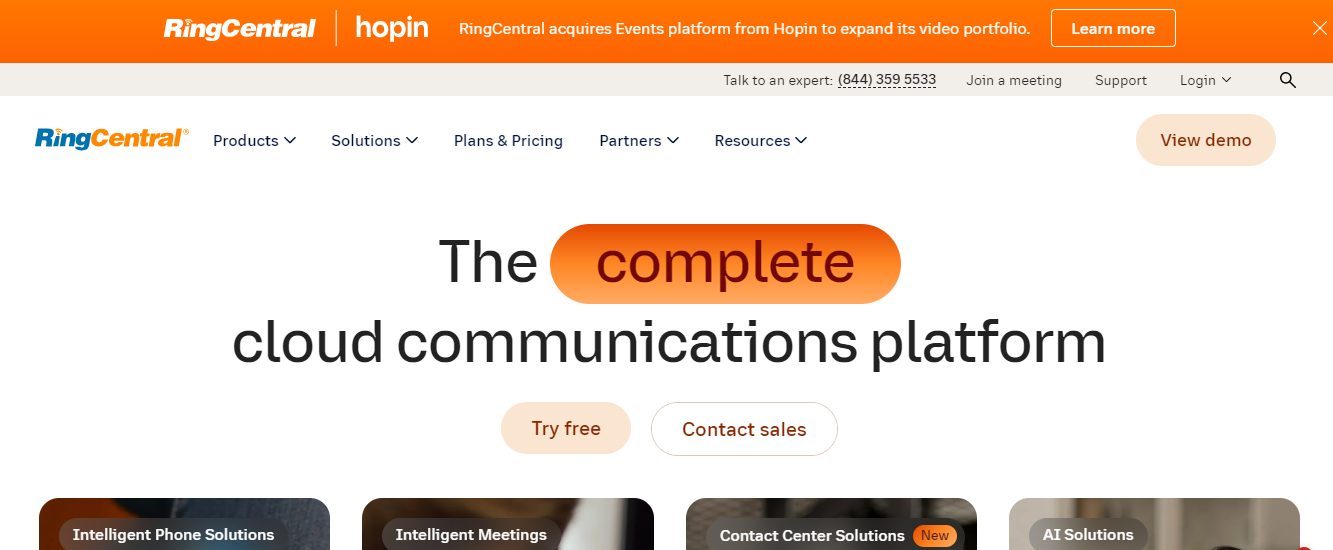
Ring Central
Ring Central es una plataforma de comunicación basada en la nube que se esfuerza por normalizar la videoconferencia como una forma de comunicación en la era moderna. Es una plataforma de confianza de muchas empresas líderes y está equipada con características como reuniones de equipo y reacciones de los participantes para mejorar la colaboración entre los miembros de un equipo.
Características
- Transcripciones en vivo
- Pizarra blanca
- Salas de reunión separadas
- Reunión de equipo
- Reacciones de los participantes
Pros
- Con tecnología de IA: Ring Central es un pionero en software que usa IA para mejorar sus capacidades. En particular, proporciona traducciones en vivo durante la videoconferencia mediante el uso de IA.
- Grabación y reproducción de video: captura la esencia de las reuniones grabándolas y permitiendo a los usuarios reproducirlas.
- Calidad HD: Ring Central está equipado con video y audio de alta calidad para mejorar la experiencia del usuario e imitar conversaciones de la vida real.
Contras
- Centrado en la aplicación: aunque Ring Central es bastante multifacético, solo está disponible como una aplicación y no a través del navegador, lo que reduce su accesibilidad para muchos usuarios que dependen de las extensiones del navegador.
- Curva de aprendizaje más pronunciada: su interfaz complicada puede ser difícil de navegar para los nuevos usuarios y puede llevar algún tiempo acostumbrarse.
- Problemas de servicio al cliente: Ring Central como plataforma es bastante buena, pero los usuarios han tenido preocupaciones con respecto al servicio al cliente de la plataforma cada vez que tuvieron problemas con la interfaz.
Ring Central es una plataforma que se centra en brindar capacidades de comunicación holísticas a los usuarios y está constantemente buscando formas de mejorar su infraestructura para que sea más accesible para los usuarios. Aunque su servicio al cliente es bastante preocupante, sigue siendo una plataforma bastante confiable para trabajar.
Conclusiones
Es probable que tu empresa ya esté equipada con una plataforma de videoconferencia, probablemente una de esta lista, pero no es una mala idea considerar otras opciones. Especialmente dado el aumento constante de la competencia y los avances tecnológicos que surgen a diario. La videoconferencia puede parecer un proceso sencillo, pero tiene muchas capas que la mayoría de los trabajadores no consideran hasta que surge un problema.
Cuando se trata de garantizar la seguridad, las plataformas como Jitsi y LiveStorm son excelentes opciones. Si te gusta ceñirte a los clásicos, Skype y Zoom pueden ser mejores opciones. Si es algo novedoso y a menor escala lo que buscas, EzTalk y Zoho Meeting están a tu servicio. Las plataformas como Teams y Slack están especialmente diseñadas para satisfacer los requisitos de las empresas que valoran la comunicación holística y se adhieren a una plataforma para satisfacer muchas necesidades. Ring Central es una buena opción para aquellos que buscan una plataforma basada en aplicaciones y Google Meet es ideal para aquellos que ya pueden estar trabajando con Google Workspace.
Independientemente de la plataforma que elijas, debes tener en cuenta las consideraciones mencionadas en este artículo. La escalabilidad es algo que las empresas no deben tomar a la ligera, ya que pueden estar sujetas a pagos injustificados si la plataforma que eligen no permite más que un número determinado de participantes en la versión gratuita. La seguridad de los datos y la integración con múltiples dispositivos es igualmente importante para garantizar que los trabajadores puedan discutir sus ideas independientemente de su dispositivo y sin temor a que sus datos sean pirateados. Las características adicionales, como la calidad del video y el audio, así como la grabación y la anotación, mejoran la experiencia del usuario.
Tu experiencia como usuario es de suma importancia al final del día y si no te sientes cómodo con la interfaz de una plataforma o no puedes justificar los recursos que se gastan en ella, entonces no es para ti. Estas plataformas existen para facilitar la conexión y agregar a la experiencia humana, pero no pueden reemplazar las interacciones cara a cara y deben tratarse con gran cuidado. La dependencia de tu empresa de la videoconferencia debe ser una que aumente su valor y no una que lo agote.






